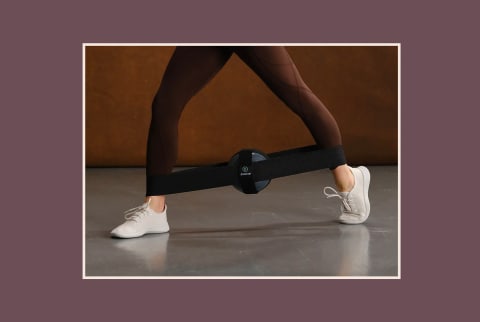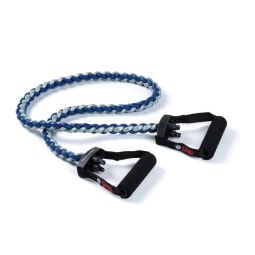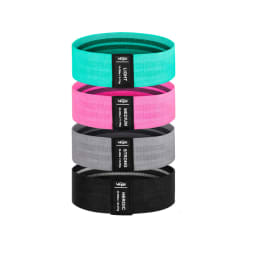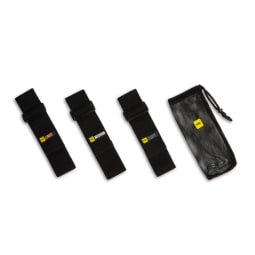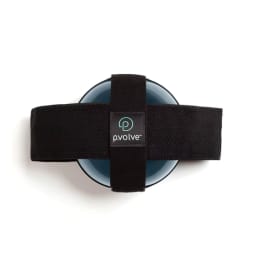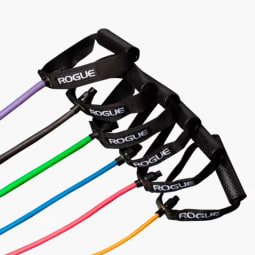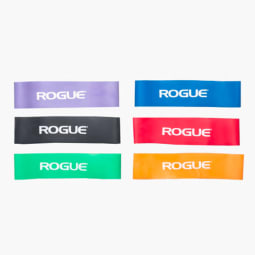Here’s what CPTs and fitness experts want you to look for in a resistance band that will fire up your glutes, plus seven of the best bands for your workouts and how to use them effectively. “Resistance bands allow for constant activation in the glutes, which can help build muscular strength and enhance form,” explains Maeve McEwen, CPT, a lead trainer at P.volve. “Resistance band exercises and weights are a great combination if your goal is building your glutes.” It’s the constant activation that’s unique. “Resistance bands keep more constant tension on the muscles throughout the whole movement of an exercise compared to dumbbells,” says Luke Zocchi, head trainer at Centr. “That creates the micro-tears you need to repair and build your muscles.” “Exercises with load have a primary purpose of building muscle, but adding bands is a great way to support muscle growth through tone and strength,” explains Mike Curry, ACE CPT and founder of StrongBoard Balance. He likes incorporating bands toward the end of a workout to really fatigue specific muscle groups like the glutes. Research confirms what these trainers are saying: Resistance band training builds strength1 as effectively as free weights. Another benefit to the band? “Resistance bands have a lower impact on your body than weights and you typically have a bit more control,” says Zocchi. That means you can really dial in the workout to activate all the muscles in the glutes, and you’ll engage various stabilizing muscles in the process. Plus, they’re super portable and easier to take on the go than your favorite dumbbell set. Some resistance bands have a tubular design with handles on either end, while others are a continuous loop. Some have a figure-eight shape or are designed as a mini loop with handles. And as you might have guessed, different bands lend themselves to different workouts, which we’ll get into below. Included handles, carabiners, ankle straps, and a door anchor in the Essentials kit mean extra versatility for different exercises and their appropriate resistance levels. The kit has a few bonus tools, too, including a foam mat, protein shaker bottle, travel bag, and a three-month subscription to the Centr app and all its training videos. These bands are sold individually, with lengths between 44 and 53 inches. Resistance weights are between 3 to 5 pounds for very light and between 20 to 27 pounds for extra heavy. This set includes four glute bands that range in resistance from light (14-25 pounds) to heroic (45-60 pounds), so you’ll have plenty of options. All four bands are the same size and color coded for ease of use. Plus, they’re nicely made with reinforced joints, and they come with their own little bag and exercise guide. The set comes with three glute bands in light, medium, and heavy resistance, plus a mesh storage bag. The bands can be hand washed and hung to dry, which is a nice bonus. Tester thoughts: I tested the P.volve method myself, and any initial skepticism I had was gone within the first five minutes. I tend to gravitate toward intense workouts—heavy weights, kickboxing—so I assumed I wouldn’t feel sufficiently “worked” with this approach to fitness. I was wrong, and the P.ball in particular is a great training tool for the glutes and thighs. My muscles feel deeply activated in a way I just don’t get with traditional weighted squats and deadlifts, and I leave every workout feeling loose and energized instead of shaky. If you fall into the “every workout should be punishing to be effective” camp, the P.ball could very well change your mind. Rogue’s bands are sold separately and in packages. The light and heavy packages come with the three lightest and three heaviest bands, respectively, and the complete package has all six bands. Tester thoughts: I personally use these bands in my home gym, and they do the job nicely. One note that the handles are textured for grip, but they’re firm – no soft foam here. The dipped latex of these color-coded bands is durable, snap-resistant, and designed for short movements—think clam shells, squats, and lateral steps. But fair warning that the material can pinch and definitely tug on body hair if you’re wearing shorts. Tester thoughts: I slip on one of these bands (over leggings!) for some lateral resistance on specific leg and glute exercises, and it’s always a next-level burn. For lateral movements, a heavier glute band is a good pick. “These smaller, wider bands are used mainly for lower-body and glute exercises, mostly focusing on the smaller muscle groups of the hips and lateral movements,” says Curry. Longer bands with handles or those designed to be knotted lend themselves to exercises like kickbacks, squats, and reverse lunges. Resistance bands are an inexpensive training tool, and many are sold in sets. That makes it easy to have a mix of traditional resistance bands and glute bands handy. Manufacturers tend to have their own color-coded system, and having bands in light, medium, and heavy resistances will give you a ton of options to really hammer those glutes. “You know you’re using the bands correctly because you’ll get a burn that feels deeper than a loaded burn from weights,” says Curry. McEwen advises putting your hands on your glutes to feel the muscles activating. “Work to then maintain that activation and tension on the band throughout the entire exercise,” she says. Try using a glute band around the quads above the knee while you squat or perform a reverse lunge, and for donkey kicks and clam shells. Handled resistance bands work well for standard squats and kickbacks. As Curry points out, resistance bands in general complement just about every workout you can imagine.



